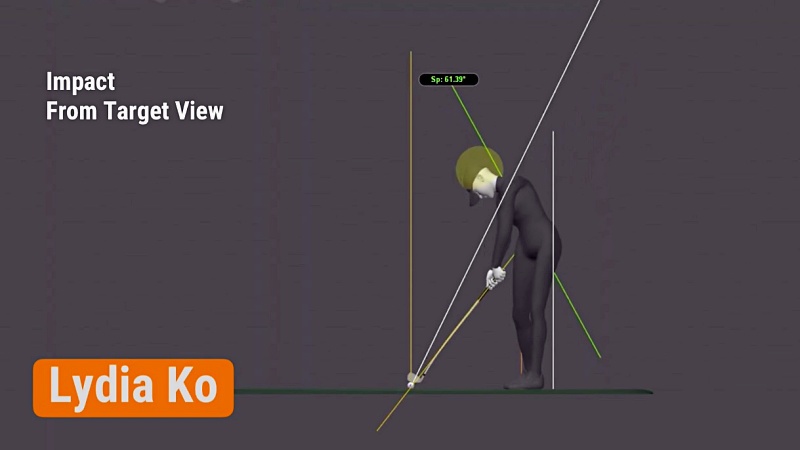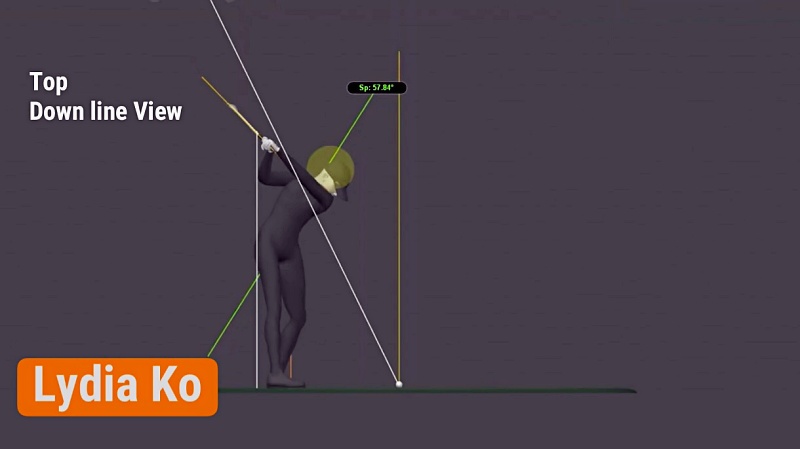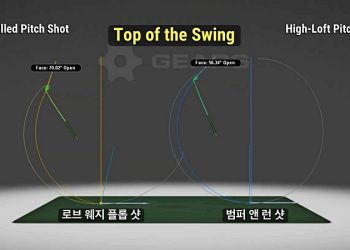프로 골퍼들의 스윙을 3차원에서 다양한 각도를 볼 수 있는 시대가 되면서 프로뿐 아니라 지도자들에게도 획기적이고 혁신적인 계기가 되었다. 스윙 시 나타나는 신체 동작과 클럽 간 유기적인 관계를 가지고 바이오메카닉스(Biomechanics) 관점에서 볼의 비행을 측정하게 되면서 볼의 방향과 거리의 문제를 해결하는 데 큰 도움을 얻게 된 것이다.
‘투어 템포’란 말이 있다. 스윙에서 백스윙 시간과 탑 동작에서 임팩트까지 걸린 시간을 비율로 나타낸 것이다. 프로들은 이 비율이 3:1 비율에 근접해 있다는 통계가 있다. 이를 ‘황금 비율’이라고 한다.
존 노보셀의 저서 ‘투어 템포’에 따르면, 대부분 프로 골퍼들은 스윙 템포에서 일관된 3:1 비율을 유지한다. 이는 백스윙이 다운스윙보다 약 3배 더 오래 걸린다는 것을 의미한다. 이 3:1 비율은 타이거 우즈, 잭 니클라우스, 프레드 커플스와 같은 전설적인 골퍼들의 스윙에서도 관찰되었다.
필자가 이번에 새롭게 시작하는 ‘3D & Biomechanics Golf’ 레슨은 기어스 골프(Gears Golf)에서 받은 자료를 바탕으로 한다. 세계적 선수들의 스윙 동작을 3차원에서 다양한 각도로 분석하면서 다양한 레벨의 골퍼들에게 도움 될 부분을 소개하자는 것이다.
먼저 2024년 대단한 활약을 펼친 리디아 고 선수의 경우를 보자. 필자와는 지난 몇 년간 현장에서 많이 만났고, 오래전 주니어 시절에 시합을 직관한 인연도 있다.
리디아 고 선수는 스윙 템포가 1/3(0.33 tempo) 비율보다는 수치가 작게 나왔다. 탑 동작까지 걸린 시간이 1.059초다. 탑에서 임팩트까지는 0.249초, 백스윙은 좀 길어 1/3 비율인 0.33보다 작은 0.23으로 나왔다. 0.33보다 작으면 스윙 템포가 느리고 더 크면 스윙 템포가 급하다고 이야기할 수 있다. 리디아 고 선수의 스윙 템포가 0.23으로 0.33보다 작게 나온 원인은 그의 스윙 동작 분석을 통해 알 수 있다.
리디아 고 선수의 스윙 타이밍이 조금 느리게 된 원인은 백스윙 초기에 나타난다. 그의 백스윙은 초기에 스윙 피봇(pivot) 역전 현상이 보이는데 이게 백스윙 시간을 늘어나게 한 것이다. 백스윙 1단계는 왼쪽 어깨가 1/4 회전을 한다. 평균적으로 이 단계에 이르면 스윙을 이끄는 왼팔이 7시 30분 방향을 가리키게 된다. 하지만 리디아 고는 왼쪽 어깨 회전 시간보다 왼팔의 움직임이 상대적으로 빠르게 나타났다. 백스윙 초기, 왼쪽 어깨 회전이 왼팔과 같은 시간으로 움직이면 스윙 템포도 1/3의 비율이 된다. 탑에서 볼 수 있는 큰 각도의 X-factor도 가능하다.


스윙 템포는 각자의 선택이며 고유의 스윙 리듬이다. 따라서 반드시 1/3의 비율이 될 필요는 없다. 기어스 골프 자료에 따르면 전인지 선수는 0.23, 크리스틴 콜만 0.27, 고진영 0.27, 넬리 코다 0.27, 이보미 0.27 등으로 여자 투어 선수들의 스윙 템포는 0.23~0.27로 다양하다.
일정한 스윙 템포는 샷의 실수를 절대적으로 줄이고 방향성도 좋게 만든다. 수치로 나타난 3:1의 스윙 템포를 일정하게 유지하게 되면, 백스윙을 적절히 완성할 수 있다. 다운스윙으로 부드럽게 전환도 가능하다. 그리고 클럽페이스에 대한 제어도 쉽게 된다.
이러한 스윙 템포는 훈련을 통해 얼마든지 만들 수 있다. 메트로놈 앱이나 특수 골프 템포 훈련 보조기구를 사용하는 것도 좋다. 필자가 사용하는 “어드레스 – 부드럽게 – 머물고 – 히트” 같은 구두 신호를 불러주는 도움이 된다.
필자는 여러 골퍼들을 지도하면서 3대 1 템포 훈련으로 스윙 스피드는 5 mph 이상, 아이언 샷 거리도 10야드 전후로 늘어난 사례를 자주 경험한다. 결론적으로, 3대 1 스윙 비율은 스윙의 일관성과 효율성 그리고 방향성과 비거리 증가로 이어지게 할 수 있다.
☞ 전욱휴는…
서울대 졸업 후 미국에 유학, 1996년 PGA 클래스A 프로가 됐다. 이후 28년만인 2024년 전 세계 골프계 최고 권위의 ‘PGA 마스터 프로페셔널’ 자격을 획득했다. SBS, MBC, JTBC, YTN 등의 골프 채널 진행자 및 해설자로 활약했고, 지금은 애틀랜타와 한국을 오가며 골프 레슨 및 골프 관련 비즈니스를 하고 있다. chungolf@gmail.com
[Dr.Eric Chun’s Golf lesson] 3D & Biomechanics Golf. Golf
The meaning of Lydia Ko’s swing tempo!
When instructing professionals’ swings, data is typically gathered from three main areas for teaching and coaching. First, “body data” from the swing is collected. Second, “club data” is necessary. Finally, “ball data” is gathered.
Ball data has largely been obtained through launch monitors. Until recently, teaching and coaching were done by visually observing the golfer’s movements along with this ball data. However, without numerical data on body and club movements, there were many limitations in discussing the overall distance and direction of the ball.
The ability to view professional golfers’ swings from various angles in 3D has been revolutionary for both pros and instructors. By measuring ball flight from a biomechanics perspective, considering the organic relationship between body movements and the club during the swing, significant help has been gained in resolving issues of ball direction and distance.
There’s a need to approach golfers’ rhythm in relation to professionals’ swing tempo.In golf, there’s a concept called “Tour Tempo.” This refers to the ratio of time taken for the backswing to the time from the top of the swing to impact. Statistics show that professionals’ ratio is close to 3:1. This ratio is called the “golden ratio.”
According to John Novosel’s research in his book “Tour Tempo,” most professional golfers maintain a consistent 3:1 ratio in their swing tempo, regardless of individual style. This means the backswing takes about three times longer than the downswing. This 3:1 ratio has been observed in the swings of legendary golfers like Tiger Woods, Jack Nicklaus, and Fred Couples. Despite their different swing speeds and styles, they all follow this common tempo, suggesting its fundamental importance to an effective golf swing.
The new “3D & Biomechanics Golf” lesson is based on data provided by Gears Golf.
We’ve decided to showcase aspects that can help golfers of various levels by analyzing the swing motions of world-class PGA & LPGA Tour players from various angles in 3D.
The LPGA Tour player we’ll be looking at this time is “Lydia Ko.” I’ve met her many times on the field in recent years and have a connection from watching her junior competitions long ago, so we decided to start with her. Lydia Ko’s performance in 2024 was particularly outstanding.
In Lydia Ko’s case, her swing tempo ratio is less than the 1/3 (0.33 tempo) ratio. The time to the top of her swing is 1.059 seconds. The time from the top to impact is 0.249 seconds. With a longer backswing time, her ratio comes out to 0.23, less than 0.33.
When the 1/3 ratio is expressed numerically as 0.33, a number smaller than this indicates a slower swing tempo, while a number larger than 0.33 indicates a rushed swing tempo.The reason for Lydia Ko’s swing tempo ratio being 0.23 can be understood by analyzing her swing motion.
From the first stage of the backswing, Lydia Ko’s swing starts with the frontal spine angle. This results in a reverse pivot phenomenon. This reverse pivot likely caused the extended backswing time.
The first stage of the backswing involves a 1/4 rotation of the left shoulder. On average, at this stage, the leading left arm points to 7:30 on a clock face.The cause of Lydia Ko’s slightly slower timing can be found in the early backswing. We can see that her left arm moves relatively faster compared to her left shoulder rotation.
If the left shoulder rotation time matches the left arm movement time in the early backswing, it’s possible to achieve the 1/3 tempo ratio. A large X-factor angle is also possible at the top. Swing tempo is a personal choice for pros and becomes their unique swing rhythm. Therefore, it’s not necessary to strictly adhere to the 1/3 ratio.
In Gee Chun’s swing tempo is 0.23, Kristen Coleman’s is 0.27, Jin Young KO’s is 0.27, Nelly Korda’s is 0.27, and BOMEE LEE’s is 0.27. Female players’ swing tempos range from 0.23 to 0.27 (data received from Gears Golf).
A consistent swing tempo absolutely reduces shot errors and improves direction. Maintaining a consistent 3:1 swing tempo allows for proper completion of the backswing, smooth transition to the downswing, and easier control of the clubface.
Golfers can develop this swing tempo through efficient training. Using metronome apps or special golf tempo training aids can be helpful. Verbal cues from the beginning of the backswing can also assist. The verbal cues I use are: “Address – Smooth – Stay – Hit”.While there are various methods, it’s crucial not to forget the importance of training at a more fundamental level where golfers can comfortably execute their backswing motion. Through effective 3:1 tempo training, I frequently experience cases where swing speed increases by over 5 mph and iron shot distances improve by around 10 yards.
In conclusion, the 3:1 swing ratio can lead to consistency, efficiency, improved direction, and increased distance in the swing.




![[전욱휴의 골프레슨] 40. 3대1 스윙 템포 만들기](https://www.atlantajoongang.com/wp-content/uploads/2025/01/Q1KakaoTalk_20250114_083253266-750x421.jpg)

















![[전욱휴의 골프 레슨] 46. 배치기(얼리 익스텐션)](https://www.atlantajoongang.com/wp-content/uploads/2025/03/photoKakaoTalk_20250306_073237889_01-350x250.jpg?v=1741361116)
![[전욱휴의 골프 레슨] 45. 임성재 '행온페이드' 샷](https://www.atlantajoongang.com/wp-content/uploads/2025/02/collage1-350x250.jpg)
![[전욱휴의 골프레슨] 44. 일관된 샷을 원한다면](https://www.atlantajoongang.com/wp-content/uploads/2025/02/QKakaoTalk_20250212_065748485-350x250.jpg)

![[전욱휴 골프 레슨] 42. 오른쪽 팔꿈치 역할](https://www.atlantajoongang.com/wp-content/uploads/2025/01/qQ1KakaoTalk_20250130_072058648-350x250.jpg)
![[전욱휴의 골프 레슨] 41. 매킬로이 파워 스윙](https://www.atlantajoongang.com/wp-content/uploads/2025/01/qQ1KakaoTalk_20250122_123635940-350x250.jpg)
